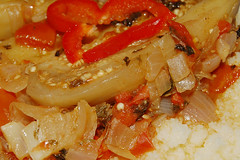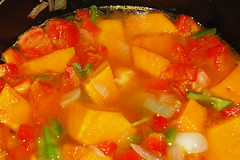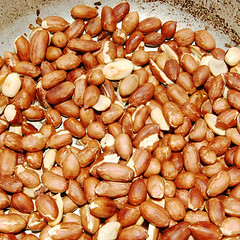This recipe I first posted on
The Great VEGA'N VEGETARIAN Project.
Now that I finally made my own recipe blog I am posting it here.
Semmelknödel with lentils are a very classic combo and I, like many other Austrians, grew up with this dish (even though some might combine it with meat or sausages).
Traditionally you use a kind of bread called “Semmel”, but you can really use any hard, dry (old) bread that absorbs some liquid, my mother even made it from whole wheat bread once.
This lentil recipe is far from being anything traditional though, as I used very un-austrian spices and instead of the cilantro I added to the dumplings, one would normally use parsley, but hey, I am in Colombia here :)
Ingredients:For the lentils:
2 cups of green lentils
4 cups of water
1 tbsp of vegetable oil
1 tbsp of Pickling spice (mustard, coriander and dill seed, laurel chillies, allspice, cloves and fenugreek) or any other spices you like
1 red onion chopped
1 tomato cut in cubes
Mint
Cinnamon
1tsp salt
sage
1 tbsp soy-sauce
For the dumplings:
8 cups hard, dry bread cut in cubes
3 cups milk
cilantro
3-4 cups flour
salt
Preparation:
After soaking the lentils in plenty of water for at least an hour or two (you might want to change the water every once in a while) take two cups full and strain them in a sieve washing them a bit under running water.

Put the lentils into a pot with four cups of water, cover with a lid and bring to a boil, then turn back to medium fire.
Lentils sometimes overflow, if this happens try to open the lid slightly or turn down the heat a bit.

In the meanwhile cut the bread into cubes, or if you have ready-made bread-cubes pour them into a bowl. Add some salt (I used around 1 tsp).

When the lentils are soft (the time it takes depends on how long you soaked them. Here it took around 15-20 minutes) remove them from the heat and strain them. You may want to wash them again, in favor of your digestion.

Heat a saucepan with 1 tablespoon of oil.
When the oil is hot enough add the onion and a bit later the tomato.
Let the vegetables fry for 1 or 2 minutes on medium heat.
Stir every once in a while, so they don’t burn.

Add the lentils and some water, spices and soy-sauce and mix well.

Here it took only around ten minutes until the vegetables were soft and the lentils starchy and flavorful.
You can wait for them to be ready and turn them off, or prepare the dumpling dough in the meanwhile.

Prepare a pot (“the bigger the better”) with lightly salted water. Bring it to a boil.
Add the milk to bowl of bread. Mix carefully, so that all the bread gets soaked, but the cubes don’t fall apart too much.

Add some chopped cilantro leaves and the flour, one half cup at a time, to get the consistency right.
Always take rather too much than too little flour, as too little might make the dumplings fall apart later when boiling. But don’t overdo it, the dough should still be a bit wet and sticky, but not be liquid (you need to be able to shape balls with your hands)



Make sure the water does not boil too wildly, as that might cause the dumplings to fall apart.
If necessary adjust the fire.
Make your hands wet and shake off the excess water, this will keep the dough from sticking to your hands.
Take some dough into your hand and shape it into a round ball, squeezing out eventual liquid.

Carefully drop the dumpling into the water and wait a bit, too see if it falls apart.
If it does, take the ruined dumpling out of the water with a little metal sieve (or any other way you can think of) and add more flour to the dough.
You might feel more comfortable starting out with a lot of flour already, to rule out any chance of this happening.
It is generally hard to predict an exact amount of required flour, because every bread is different and absorbs a different amount of liquid.

When you made sure that the test dumpling doesn’t fall apart after 10-20 seconds add some more dumplings, making sure to wet your hands before shaping every single one of them.
Don’t overcrowd the pot, the bigger it is, the more dumplings you can cook at a time.
You may have to adjust the temperature several times, to keep them in a steady but not too strong boil.
After around 10 minutes they should be ready, but to make sure you can take one out of the water and cut it in half.
In this picture you can see, that in the center of the dumpling, there is still some “raw” part.
If your dumpling looks like this, give the others some extra minutes.
 You are now ready to serve!
You are now ready to serve!(In the picture you can see that I served it with slices of raw tomato, some leaves of cilantro and “suero costeño” = coastal style Colombian sour-cream)




























